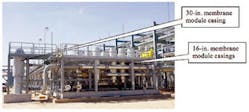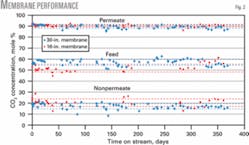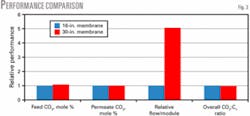The Cynara division of Natco Group Inc. has developed and field tested a large-capacity gas separation membrane module. The 30-in. membrane system has a fourth as many membrane cases, reducing footprint and weight by at least 50%, and resulting in cost savings of 20-30% compared with an equivalent 16-in. membrane module design.
The 30-in. module was placed into production service at Natco’s plant in Snyder, Tex., in March 2005. A year of operational experience demonstrates that the 30-in. module has higher-than-predicted capacity while maintaining performance equal to or better than four of the 16-in. modules at similar flow rates.
Since starting up in 1983, the Snyder plant’s feed capacity has increased to 600 MMscfd from 70 MMscfd and has steadily increased in CO2 concentration to 87 mole % from about 40 mole %.
To accommodate increasing flow requirements, membrane element diameters have grown from 5-in. OD by 41-in. long, to 12-in. OD by 41-in. long, to 16-in. OD by 72-in. long. The most recent development is the 30-in. OD by 72-in. long membrane module.
Larger modules will have relevance in the weight and footprint-sensitive CO2 separation applications, including offshore platforms and space-limited onshore locations.
Plant history
Natco operates four large CO2-removal units in its Snyder, Tex., plant using Cynara membranes. Natco owns three of these facilities, with the fourth owned by a major gas producer and operated by Natco.
The Snyder plant was the first facility commercially to use membranes for CO2 removal from a natural gas stream. The plant has a combined inlet capacity of about 600 MMscfd. The separated, high-concentration CO2 is used for enhanced oil recovery.
The Cynara membrane facilities first started up in 1983 with two small plants capable of feeding 20 MMscfd and 50 MMscfd. The two plants were combined into one system after a few years’ operation. They were upgraded and expanded in capacity to 100 MMscfd total capacity. This expanded original plant is still in full operation today.
As the field capacity and the CO2 content of the produced gas continued to increase, a second plant was added, capable of processing up to 80 MMscfd in a true bulk cut from 85% CO2 down to about 55% CO2. Nonpermeated gas from this facility is added to the membrane feed at the original plant after its pretreatment equipment.
The operator began a more intensive CO2 injection program in 2001. This resulted in greater produced gas volumes and higher CO2 concentrations as the field oil production has responded to the more vigorous enhanced oil recovery program.
The third treatment plant entered service in December 2003 and added an additional 187 MMscfd of capacity. Almost immediately, another 187-MMscfd capacity plant was constructed in parallel; this fourth facility started up in September 2004.
The membrane plants at this location are the longest running and largest capacity CO2 membrane facilities in the US. Historically, they were the first commercial application of membrane technology for removing CO2 from natural gas.
Currently, the plant has removed more than 553 bcf of CO2 since start-up with a combined total online availability of greater than 99% for the membranes and associated pretreatment equipment. The plant typically processes an inlet stream of 555 MMscfd of about 86.5% CO2 and recovers 464 MMscfd of CO2 at about 95% CO2 purity while delivering a hydrocarbon-enriched stream with less than 10% CO2 and a liquid stream of about 3,950-b/d condensate.
Membrane description
Table 1 describes the relative sizes of various membrane modules. Natco’s systems at the Snyder plant use all the different membrane module sizes. The original installation from 1983 uses 5-in OD membranes and subsequent expansion work at the original facility uses 12-in. OD membranes.
The newest facilities, built since 2001, all use the 16-in. OD membrane modules. The 16-in. membranes provide separation and flexibility for flows experienced at these facilities.
A 30-in. membrane module, of identical length to the 16-in. modules, was installed in a similar second-stage service to provide an operational evaluation of its performance relative to the 16-in. membranes. An intermediate-sized module, 24-in., was also built, underwent preliminary testing, and may ultimately be installed in the plant for field performance evaluation.
Natco’s experience with increasing membrane module capacity at the Snyder facility reflects the demands of the industry as a whole. The need for more capacity has increased demand for improved membrane designs and larger membrane modules.
From 1983-91, 5-in. membrane modules were sufficient. This continued until increased demand led to the development of 12-in. membrane modules in 1991. From 1991-2000, the 12-in. membrane modules were the size predominantly supplied.
After 2000, the 16-in. membrane modules became the size predominantly supplied. Although the 30-in. membrane module may not necessarily replace the 16-in. size, demand for larger modules is expected to increase.
The Natco Cynara membrane module consists of many fine, hollow polymer membrane fibers suspended between two tube-sheet structures; the hollow fibers extend from one end of the module to the other. Feed gas is introduced to the sides of the modules and travels radially toward a center, nonpermeate collection tube.
As the high-pressure gas contacts the membrane fiber walls, CO2 preferentially permeates through the membrane walls to the low-pressure centers of the hollow fibers. The permeate passes out the ends of the tubesheets. Feed gas is separated into a CO2-enriched permeate stream and a CO2-reduced nonpermeate stream.
One key feature of membranes is that they are resilient to most hydrocarbons that condense in the separation process. The membrane casings are therefore designed with small liquid separation systems so that the nonpermeate gas stream separates from the nonpermeate liquid stream.
The capacity of a membrane module is typically about proportional to the available membrane surface area for a fixed set of process conditions. Because the 30-in. modules have four times the active surface area of the 16-in. modules, we expected the capacity to be equivalent to four 16-in. modules.
Applying the 30-in. membrane
The 30-in. membrane module was installed in place of the first of two sequential substages of a second-stage skid. This second-stage skid originally had 10 case connections, arranged as four parallel 16-in. membrane modules in the first substage, which fed six 16-in. membrane modules in parallel.
Four 16-in. membrane modules were removed from service for this test and replaced with one 30-in. module. For this retrofit, modified piping connected a new casing for the 30-in. membrane module in parallel with the four 16-in. modules. These four 16-in. membrane modules were then isolated from service.
Fig. 1 shows this arrangement. The 30-in. membrane module replaced the service of four 16-in. membrane casings in that train.
For this application, the 30-in. membrane module receives a feed CO2 of about 57 mole % and removes sufficient CO2 to produce about 20 mole % CO2 in the gas feed to the next set of membranes. The 30-in. membrane handles about 26 MMscfd at 550 psi and about 70° F. Permeated gas from this membrane feeds a 40-psi system.
Data collection
The operational data used in this study were acquired via an interactive computerized control and data-collection system. It collects pressure, temperature, and concentration data. We obtained concentration data with a multichannel gas chromatograph.
Operators collect data through a graphical control interface program. This remote access interface allows plant operators to select and view any online skid for performance testing. Upon selection, the control system switches the appropriate solenoid valves and directs the gas samples from the skid into five streams in the online gas chromatograph.
After the streams are sampled and recorded automatically, another interface program permits collection of various flows, pressures, and temperatures to provide a complete snapshot of the current skid operating conditions into a data log file for later processing. Complete test performance data of the subject test skid was collected at least weekly.
For comparison, we collected reference data from an independently operated, unmodified parallel train. The data from the modified train with a 30-in. membrane module were compared with reference data from the unmodified train with four 16-in. membrane modules.
Performance, capacity
We compared feed compositions to the test train (with one test 30-in. membrane) and the reference train (with four reference 16-in. modules) for validation. The average feed CO2 of the 30-in. module was 57.0% and that of the 16-in. module was 51.8%.
This difference was due to the performance of the respective first stages. The number of membranes installed, as well as age and operational history of the respective first stages were different.
Based upon statistical inference, the difference was small enough for comparison of the two conditions. Because this is an operational facility, the object was to compare similar feed conditions, but no attempt was made to match the feed compositions precisely.
Fig. 2 shows the stream compositions of the 30-in. module along with reference system’s performance. Dotted lines are added at plus and minus one standard deviation from the mean to indicate the relative scatter in the data. The similarity in the permeate concentrations demonstrates that the performance of one 30-in. module is comparable to that of four 16-in. modules.
We calculated nonpermeate compositions using a material balance from the feed and permeate concentrations. Overall, the stream compositions were similar and useful for further comparison.
Fig. 3 shows that neither the 30-in. test membrane nor the 16-in. reference modules exhibited any noticeable performance decline in more than a year of service, as measured by CO2-removal capacity and the ability to separate CO2 from hydrocarbons. For each case, performance remained remarkably consistent.
We expected that capacity of the 30-in. membrane module would be equivalent to the relative amount of surface area, about four times that of a single 16-in. membrane module (Table 1). Despite the slightly higher feed composition, the 30-in. membrane modules had a higher-than-anticipated flow capacity.
Fig. 3 summarizes average data. Averaged flow for the 30-in. module was about 5.08 times that of a single 16-in. module in approximately identical service, while giving similar performance.
Economic evaluation
Most of the capital cost, footprint size, and weight of a membrane skid is attributable to membrane housings, piping, valves, and structural steel. Footprint and weight are an obvious consideration with expensive deck space and structure ramifications.
In an appropriate application, choosing a 30-in. membrane module can result in significant savings by reducing cost, size, and weight.
We designed two skids to estimate the potential savings of the 30-in. membrane module vs. a corresponding skid using 16-in. membrane modules. The 16-in. module skid design contains sixteen 16-in. modules in a skid with piping, and has a footprint of about 275 sq ft. The 30-in. module skid design contains four 30-in. modules, with a footprint of about 124 sq ft, representing a footprint savings and a weight savings of about 55%.
The cost savings of the 30-in. membrane module skid vs. the 16-in. skid is about 25%.
To design a membrane system for performance control, it is necessary to allow for a minimum number of membrane modules. The number of membrane modules can become excessive, however, with the ever-increasing capacity requirements of gas membrane projects. Because of this, membrane module capacities must increase to keep pace. Demand for high-surface-area membrane modules will increase further in high-capacity designs.
The authors
Justin Marquez Jr. ([email protected]) is a senior process engineer at Natco Group Inc., Houston. He has also served as manager of engineering at Production Operators Inc. Marquez holds a BS in chemical engineering from Mississippi State University.
Mark Brantana ([email protected]) is process engineer at Natco Group Inc., Houston. He has also served as process manager at Kvaerner Process Systems. Brantana holds a BS (2001) in chemical engineering from the University of Houston. He is a member of SPE and GPA.








